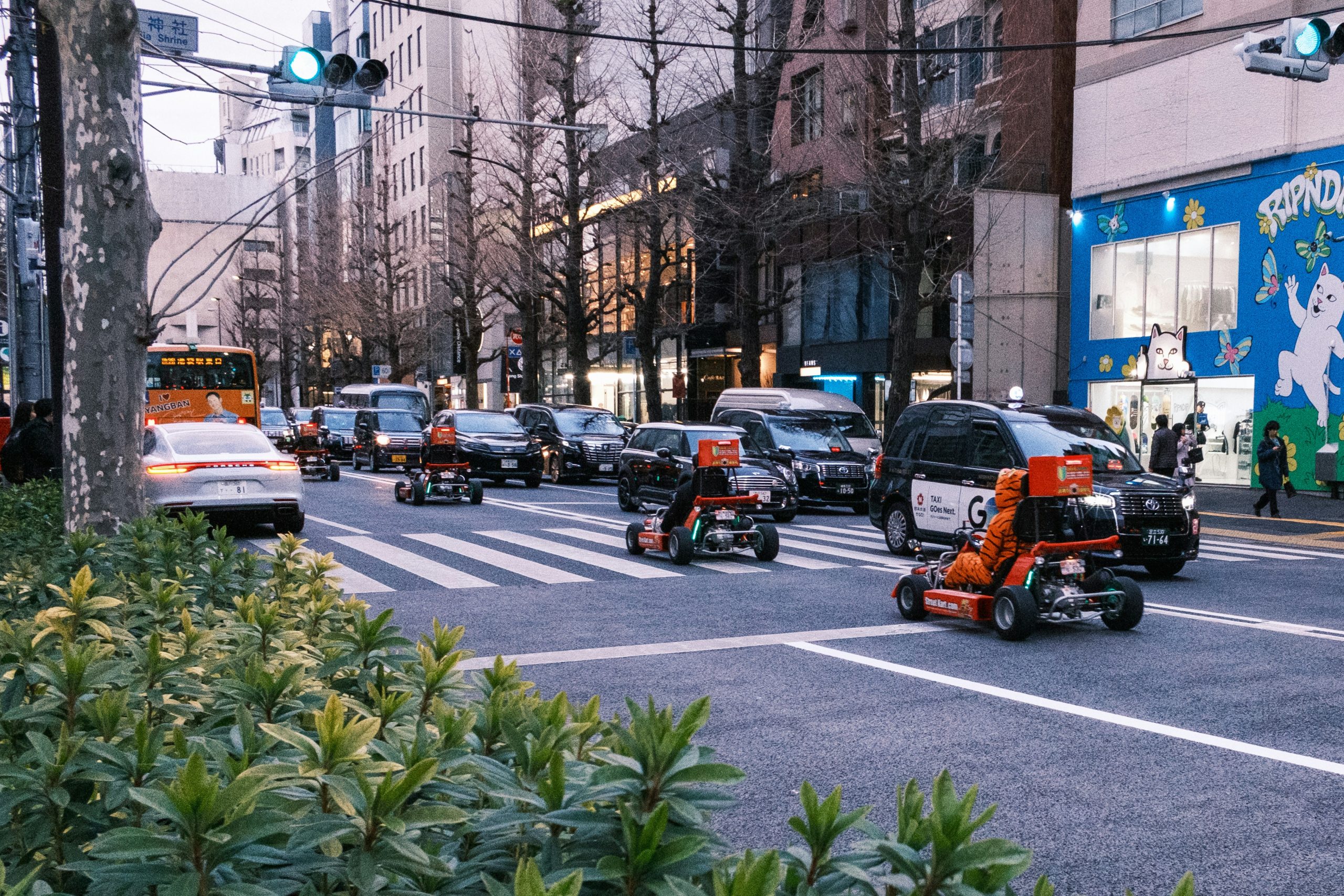You know what hits you first about Tokyo? It’s this incredible buzz, right? Neon everywhere, those iconic crossings you’ve seen a million times – it’s like stepping into a movie. And then, out of nowhere, you spot them: a little convoy of go-karts, maybe someone dressed as Pikachu, zipping past a seriously majestic building. It’s one of those “did I just see that?” moments that sticks with you. And yeah, the thought of doing it yourself – cruising past, say, the Skytree in your own little ride – sounds absolutely epic. But then that little voice pops into your head, the one your mom always had: “Is that… safe?”
Honestly, it’s a fair question. You’re in a foreign country, on roads you don’t know, in what’s essentially a glorified go-kart. So, let’s ditch the corporate speak and just lay it out. This is your friendly, (mostly) comprehensive guide to staying rubber-side down and having a blast go-karting through Tokyo.
First Off: Public Roads and Go-Karts? What’s the Deal?
Here’s the thing that might surprise you. Unlike those go-karts at the local fairground that are confined to a tiny track, in Tokyo, you’re often on the actual, real-deal public roads. That means you’re sharing the asphalt with everything from those super polite Japanese buses to the zippy little scooters and, yeah, a whole lot of pedestrians who might not be expecting a Mario Kart parade.
So, rule number one (and this is non-negotiable): you’ve gotta play by the same traffic rules as everyone else. Think of your go-kart as just another car – a tiny, ridiculously fun car, but a car nonetheless.
- Your License is Your Golden Ticket: Forget just showing up and hopping in. You absolutely need the right kind of driving permit. For most tourists, that boils down to either a Japanese driver’s license (unlikely on a short trip), an International Driving Permit (the IDP, based on the 1949 Geneva Convention – make sure it’s that specific one!), or if you’re from a select few countries (like Switzerland, Germany, Belgium, Monaco or France), your license with an official Japanese translation. Seriously, sort this out before you even think about booking. No legit license, no go. End of story. Check out our JAF-certified translation service here, starting from only 49 Euro.
- Traffic Lights Are Not Just Pretty Decorations: Red means stop. Green means go. Seems simple, right? But you’d be surprised. You’ve got to stop at those red lights, yield to people crossing the street (Japanese pedestrians are pretty good about waiting, but still!), and stick to the speed limits. Treat those traffic signals and signs like they’re gospel.
- Stay in Your Lane, My Friend: Those big, wide highways and toll roads? Nope, not for go-karts. You’re sticking to the regular lanes. Pay attention to the painted lines and stay where you’re supposed to be. It’s not a free-for-all.
- Keep it Sober, Seriously: This should be a no-brainer, but driving under the influence in Japan is a major offense, with some serious consequences. Save the sake for after you’ve parked the kart.
- Buckle Up If You’ve Got One: Some of the karts on closed circuits might skip the seatbelt, but if your street-legal machine has one, use it. It’s just common sense, like putting on sunscreen – you might not think you need it, but you’ll be glad you did.
Going Solo vs. Rolling with a Crew: What Makes More Sense (and is Safer)?
Okay, in theory, if you’ve got the right license and you’re some kind of Tokyo road-whisperer (unlikely for most visitors), you could try to rent a go-kart and just head out. But honestly? For almost everyone, especially if it’s your first time navigating the organized chaos of Tokyo’s streets, a guided tour is the way, the truth, and the light. And yeah, it’s way safer.
Why Guided Tours Are Like Having a Guardian Angel (with a Go-Kart):
- They Know the Secret Paths (and the Dangerous Ones): These guides do this for a living. They know the safest routes, the intersections that can get a bit hairy, and how to get you from A to B without you ending up accidentally on the wrong side of the Imperial Palace.
- Their Karts Are (Usually) Well-Loved: Reputable tour companies aren’t going to send you out on a clunker. They usually keep their go-karts in decent nick, which means less chance of a breakdown leaving you stranded and feeling like a character in a low-budget action movie.
- They’re Your Lifeline If Things Go Pear-Shaped: Flat tire? Got a bit lost in translation with a local? Your guide is there to help. They can communicate if you need assistance from the police or paramedics. It’s like having a translator and a mechanic rolled into one.
- They Speak Your Language (Probably): Most tours aimed at international folks will have guides who can explain the rules and directions in English, so you’re not just nodding along, hoping for the best.
Seriously, for peace of mind and a smoother, safer experience, especially on your first go-karting rodeo in Tokyo, stick with a guided tour.
Street Smarts 101: Keeping Yourself Out of Trouble on Tokyo’s Roads
Tokyo’s a blast, but its roads can be a bit of a… well, a lot. Staying sharp and following some key safety tips is crucial when you’re in a go-kart:
- Intersections Can Be a Zoo: Places like Shibuya Crossing? It’s not just a tourist attraction; it’s a serious hub of activity. Same goes for busy spots in Shinjuku. Approach intersections slowly, keep a good distance from other vehicles (those taxis can be nippy!), and be ready to brake. A lot.
- Pedestrians Are Everywhere (and They Have Right of Way): Tokyo sidewalks are often packed, and people will be crossing streets.1 Always yield at those zebra crossings, even if they haven’t fully stepped onto the road yet. And keep an eye out for sudden movements – you never know when someone’s going to dart out to catch a train.
- Some Roads Are Surprisingly Tiny: Especially in older neighborhoods, the streets can get really narrow. Take extra care when turning corners or passing parked cars. Give yourself plenty of room – those little go-karts aren’t exactly tanks.
- Mother Nature Has a Say: Rain makes everything slippery and harder to see. Good tour operators will usually cancel if the weather’s looking dodgy, but it’s always smart to check the forecast yourself. Driving a go-kart in the rain? Not exactly a recipe for fun (or safety).
- Those Lights and Signs? Pay Attention!: Tokyo’s got its own rhythm when it comes to traffic lights, including specific turning signals and pedestrian crossing indicators. Make sure you understand what they mean. Getting it wrong can lead to some seriously awkward (and potentially dangerous) situations.
Okay, Worst Case Scenario: What Happens If There’s a Bump in the Road?
Accidents are rare, thankfully, but they’re also a reality. That’s why picking a reputable go-kart company that takes safety seriously and has insurance sorted is so important.
Stuff You Really Need to Know:
- Insurance is Usually Included (But Don’t Just Assume): Most tour companies will bundle some basic liability insurance into the price. This usually covers damage you might cause to other people or their stuff. But it might not cover damage to your go-kart or if you get hurt. Ask the tour operator for the specifics before you sign up.
- You’ll Need to Call the Cops: If there’s an accident, you’re legally required to report it to the police. Your guide will usually help you with this process, including the language barrier.
- Know Who to Call in an Emergency: For a serious injury, the number for an ambulance is 119.2 For the police (if it’s not a medical emergency), it’s 110. Your tour staff should be able to help with communication if needed.
- You Could Be on the Hook: Depending on who caused the accident, you might be financially or even legally responsible. That’s why driving carefully and understanding the rules is so crucial. Read the fine print of your rental agreement.
Getting Ready to Roll: Some Pre-Karting Prep
A little bit of homework before you jump into that go-kart can make a huge difference in how safe and enjoyable your adventure is.
Your “Before You Drive” Checklist:
- License, One Last Time! Seriously, triple-check you’ve got the right driving documents before you head out. They’ll likely want to see them.
- Dress Smart (and Comfy): Wear clothes that let you move easily and are appropriate for the weather. Avoid anything too baggy that could get caught in the kart’s mechanics.
- Listen to the Safety Spiel: When the tour guide gives you the safety briefing, pay attention! They’ll go over the specific rules, the route, and any potential hazards. Don’t be that person who’s checking their phone – this stuff is important.
- Use the Safety Gear They Offer: If they provide helmets, gloves, or even those fun costumes, use them! A helmet, even if it’s optional, is just a smart move.
- Phone Down, Eyes Up! I know you want to capture every moment, but using your phone while driving is dangerous and against the law in Japan. Also, don’t just hop out of your go-kart in the middle of the road to take a selfie. If you stop at a light, a quick snap is okay, but stay in your kart.
Final Thoughts: Go Have Fun, But Keep Your Wits About You
Go-karting through Tokyo can be an absolutely unforgettable way to see the city, a real blast of adrenaline mixed with sightseeing. But it’s not a theme park ride. You’re on real streets with real traffic, so respecting the rules, choosing a good tour, and staying alert are the keys to having an amazing and safe experience.
So, go ahead, cruise through Akihabara’s electric town or wave at the crowds in Shibuya. Just remember that safety is the name of the game. With a little preparation and a responsible attitude, your Tokyo go-karting adventure can be one of the highlights of your trip. Just be smart out there, okay? You don’t want to end up as a cautionary tale.


Leave a Reply